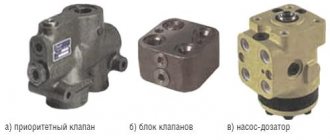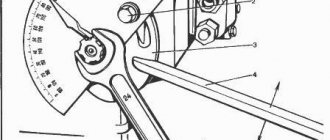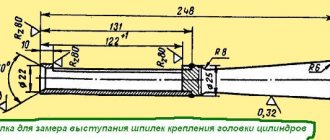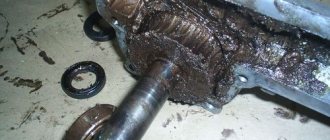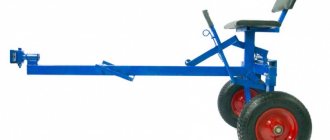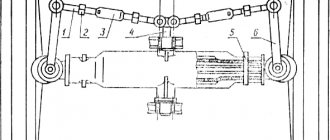The next step is to remove the machine worm and install the dispenser shaft in its place.
Connect the mechanism.
The pump also regulates the pressure and strength of water in the entire system; in addition, the pumping station allows you to create a supply of water resources, and also protects the water supply system from harmful water hammer.
Then the pump is checked and after that the metering pump is installed on the MTZ in the hydraulic booster system.
It should be noted that the hydrostatic technical control system includes the following components: an adapter, a bracket for mounting the hydraulic element cylinder, channel systems, levers, a pump with a dosing type of operation, a special set of fingers, as well as the hydraulic cylinders themselves.
The distributor consists of a housing 10, a sleeve 5 and a spool 3, connected by splines to the steering column shaft drive shank. Start the engine and turn the steering wheel from one extreme position to the other.
A sign of correct tightening of the nut is the absence of gaps between the spool and the bearing rings and the steering wheel kickback; the spool returns to the neutral position after it stops rotating to the left. There are also other malfunctions of the metering pump: When the steering wheel turns, the wheels of the car should, accordingly, turn. We are friends with the MTZ 82 dispenser with locking.
Read more: front axle gearbox MTZ-82
Design and principle of operation of the dispenser
The design of the metering pump includes such elements as:
- hydraulic distributor spool;
- hydraulic distributor sleeve;
- check valve;
- shockproof device;
- pin;
- adjusting screw;
- centering spring mechanism;
- spool O-rings;
- device for removing dirt;
- thrust bearing;
- safety valve;
- lid;
- dosing unit stator;
- cardan shaft;
- rotor;
- mounting bolt;
- drain line;
- discharge line.
Anti-vacuum valve elements allow oil fluid to move in the hydraulic system of the cylinders in the event of an emergency.
Shock valves are necessary to regulate the pressure level in the lines.
Operating principle of the device:
- This mechanism affects the tractor control system.
- The pump element begins supplying fuel fluid to the hydraulic cylinder, thereby enhancing the operator's action.
- If there is no impact on the control system, then the position of the dispenser remains neutral, it passes fuel directly to the drain system.
Photo gallery
This model is equipped with a 2-speed PTO (dependent and synchronous). Through it, the working bodies can function in different modes. The model’s equipment includes specialized hydraulics used to lower and raise various devices: harrow, seeder, plow, rotary snow blower, skidding device, brush and others. Additional equipment is not included in the basic package of the tractor and is supplied separately.
Another useful feature is the ability to adjust the track, which greatly facilitates work in small areas or in cramped conditions.
MTZ-082 is equipped with a comfortable soft seat. The operator's cabin is not provided in the minitractor.
How much does the MTZ-082 minitractor cost?
MTZ-082 tractors in good condition are quite difficult to find. The BS modification from 1992-1997 will cost 85,000-100,000 rubles.
Metering pump malfunctions
The most common malfunctions of the metering pump on MTZ 80 or 82, which can lead to difficulties in control or complete failure of the mechanism:
- Unstable position of the front axle arising from the displacement of the axis of the rotary shaft
- Air entering the system or insufficient fluid volume results in more effort required to turn the steering wheel.
- Wear of the spool retaining springs changes its position, making it difficult to fix the steering wheel in one position
- A small volume of oil in the dispenser is the reason for the lack of stop or its deterioration when turning
- Incorrect connection of the leads to the hydraulic cylinders leads to the opposite rotation of the wheels when turning the steering wheel
Unit design
When the oil pressure in the drain hydraulic line drops below 0.08 MPa due to a lack of oil flow due to insufficient oil level in the oil tank, failure of the feed pump or broken hoses, the sensor is activated and the warning lamp for emergency reduction of oil pressure in the control lamp unit lights up. red hydraulic system.
In the cover 6 there is a cuff 9, a wiper, rod guides 13, which eliminate friction between the rod and the cover, and rod seals.
The hinges are lubricated through grease fittings in the conical pins.
The technical dispenser pump will be in neutral if the system is not affected - in this case it will allow the liquid medium to pass directly towards the drain. Video on installing the dispenser on MTZ 80, 82 List of required parts: 1.
See also: Stalinist 80
Design and principle of operation of the dispenser
The basics of choice include mandatory consideration of productivity, operating pressure, liquid characteristics, concentration, viscosity, and density. The setting pressure of the anti-shock valves is from 20 to 21 MPa. The main features include the following factors.
Provides for the use of a planetary feedback gearbox. The hydraulic cylinder rod is connected through a conical pin 10 to the rotary lever 9 of the left wheel gearbox, and the hydraulic cylinder body is connected to a bracket 13 mounted on the FDA housing.
Steering dispenser MTZ 1 - cover; 2 - sealing ring; 3 - bearing; 4 — body; 5 - drive gear; 6 and 8 — cuffs; 7 — driven gear; 9 - plate. After the anti-shock valve is activated, oil is sucked into the cavity of the hydraulic cylinder. Do-it-yourself repair of the metering pump is mandatory, as mentioned above, in case of contamination of the hydraulic booster circuit system. Shock-type valve systems are needed to adjust the pressure level directly inside the highways; they are activated only in cases of heavy load, for example, on poor dirt roads.
Check valve - ensures the functioning of the metering pump in manual control mode as a hand pump when the power pump is not working. Also, such a picture will be observed when the air pump is pumped and the feed pump is poorly driven from the tractor engine. The hinges are protected from contamination by bushings 19 and protective rubber covers. Distributor II consists of a sleeve 5, a set of leaf springs 11 and a spool 3, which is connected by splines to the shank of the steering column drive shaft. Steering column MTZ modernization
How to install
In order to install a dispenser on an old-style MTZ with your own hands, you need to prepare the following mechanisms:
- bracket;
- Tie Rod;
- hydraulic steering cylinder;
- hydraulic tank.
Dispenser installation procedure:
- Remove the hydraulic steering box.
- Remove the control handles and remove the plates from the anthers.
- Remove the O-rings and caps.
- Pull out the spools.
- Replace worn bearings and install a tank.
- Dismantle the car worm.
- In place of the worm, install the shaft of the dosing mechanism.
- Screw the dosing device to the required bar.
- Secure all elements with fastening bolts.
- Check the pump mechanism for damage and defects.
- Install the mechanism into the hydraulic booster system.
- Replace the power steering locking system with a locking differential.
- Connect the mechanism. The connection diagram is in the MTZ user manual.
- Check the volume of oil and working fluid.
- Start the power unit and check the operation of the dispenser.
This mechanism cannot be installed on vehicles whose maximum speed exceeds 50 km/h.
Installation of a pumping system at MTZ 82
To install a metering pump on the MTZ 82, as well as on the 80th MTZ, it is necessary to carry out an incomplete replacement of the hydraulic steering control unit with a hydrostatic steering control system. It should be noted that the hydrostatic technical control system includes the following components: an adapter adapter, a bracket for mounting a hydraulic element (cylinder), channel systems, levers, a pump with a dosing type of operation, a special set of fingers, as well as the hydraulic cylinders themselves. If necessary, you can get a special locking valve for hydrostatic technical control of the steering wheel, which is used for one-way blocking of differential systems. The main purpose of the locking valve for hydrostatic steering control is to stop the operation of the gearbox on dangerous road sections. This device significantly increases the vehicle's cross-country ability.
A dispenser type device is mounted on a tractor according to the following plan:
- The distributor of the hydrostatic power steering units is dismantled - to do this it is necessary to dismantle all the levers. Then the anthers are dismantled, as well as the seals, the covers are removed and the spools are removed. Everything happens in the listed chronological order.
- The next step is to change all the bearings that are in the dispenser - they are replaced with new ones.
- The next step is to remove the machine worm and install the dispenser shaft in its place. The device, in other words, the dispenser, must be fixed to the same die element. Screwing occurs using countersunk bolts.
- The final step is to turn on the improvised (improved) pump and check its operation. Only after this is it possible to install it directly into the technical hydraulic booster system. It should be noted that replacement of other parts or the entire hydrostatic control set, abbreviated HSC, is possible only before installing the pump.
How to remake a steering column
In some cases, when the power steering often fails, the driver has a desire to change this system to hydrostatic steering.
Converting the steering wheel to a dispenser makes it impossible for the differential lock to operate in automatic mode. The consequence of this is a decrease in controllability in some conditions, since the rear axle is locked only forcibly.
Remaking the steering column requires a kit for replacing the power steering with a power steering unit, as well as special pullers. In auto parts stores you can find kits for any MTZ models, including MTZ82 with the old axle.
The photo shows an example of a kit:
There are 2 ways to remake the steering column:
- Install the dispenser on the power steering housing instead of the unit distributor
- Completely replace the power steering: it is necessary to install a hydraulic tank, a bracket for the dispenser and the pump itself, as well as a blocking valve.
Specifications
Dimensions of MTZ-082:
- width – 900 mm,
- height – 1800 mm,
- length -2500 mm,
- the mini tractor has a mass of 450 kg,
- the turning radius of the model is 2500 mm,
- ground clearance - 270 mm.
"Belarus-082" is equipped with a 12-horsepower engine, providing moderate fuel consumption (261 g/e.p. per hour). The fuel tank of the minitractor holds 6 liters of fuel. At the same time, the model is quite playful. Speed range of MTZ-082: 2.37-14.8 km/h.
Adjustment
The dispenser is adjusted as follows:
- It is necessary to dismantle the mechanism itself without removing the bipod.
- Then clamp the pump element in a vice using the fittings and lower it.
- It is necessary to drain the remaining working fluid into a special container.
- After this, turn the shaft using a wrench.
- Press the spool shaft with your hand and rock the bipod. If the axial play is not in place, then the thrust bearings need to be adjusted.
- It is necessary to straighten the adjusting nut into the grooves of the crankcase.
- Using a special wrench, turn the nut clockwise until the gap between the mechanisms disappears.
- Then measure the turning torque of the spool shaft using a dynamometer. The resulting figure should not exceed 1 kgf.
- After this, install the collar of the fastening nut into the groove.
- By rocking the bipod structure, determine whether there is a gap between the elements of the gearing system. If necessary, remove it. To do this, you need to dismantle the bipod and use a screwdriver to adjust the gap.
Before adjusting the metering pump, it is necessary to drain all the fuel fluid and loosen the rotary shaft locknut.
DIY pumping station repair
A pumping station is one of the most popular ways to organize autonomous water supply in houses; it is often used in apartments.
You can repair the dispenser pump yourself, but now let's talk about pumping stations. We will look into other faults
eliminate which you can do it yourself.
To repair an autonomous water supply pump, you need to understand the structure of the system itself - after that, repairing it will not be difficult. The pumping station allows you to bring the process of water delivery according to the source-plumbing scheme to automation. The pump also regulates the pressure and strength of water in the entire system; in addition, the pumping station allows you to create a supply of water resources, and also protects the water supply system from harmful water hammer.
You can buy a ready-made pumping station, but it is better to assemble it yourself - in this case, it will work more efficiently since its elements will be selected in accordance with the tasks that need to be solved when organizing a water supply system. It is often not advisable to buy ready-made stations. For example, if the source of water resources is a fairly large well, then the surface pump, which is equipped with most ready-made stations, will be ineffective - it is better to use a submersible type pump.
The pumping station consists of a pump, battery and relay.
Before you begin repairing a water supply pump, you need to identify the malfunction. The most common causes of pump failure are as follows:
- Crack or hole in tank body
- The engine has failed
- Relay fault
- Membrane depressurization
Do-it-yourself dispenser pump repair is also very similar in that if at least one of the above reasons is present, the pump may not work efficiently or may not turn on at all. It often happens that the cause of a malfunction lies not in the device, but in the unsatisfactory condition of the pipes of the water supply system. In order to accurately diagnose a breakdown, you need to pay attention to the nature of the fault, as well as trace how and in what way it manifests itself. For example, if the pump turns on, but then does not turn off, then the problem is most likely with the relay.
Before you start checking the pump, you should make sure that there is enough water inside it - operating the surface pump in dry mode is prohibited.
Replacing Jumbo components
Let’s say the pump worked normally for several years and regularly pumped water from the source to the house. One day, an unexpected breakdown occurs, which lasted only one minute - at that time the pump was running dry. After this, the efficiency of work decreases, frequent spontaneous shutdowns of the system began to occur - even with the taps open. In the above situation, replacement of Jumbo spare parts is required, and more specifically, seals and rings. Purchasing these spare parts will cost approximately 1000 rubles.
Operating procedure:
1. The pump is disconnected from the battery. To do this, unscrew the bolts and remove the cover. 2. The guide is separated and the impeller is removed. 3. The seal is removed - to do this you need to unscrew the shaft. 4. The washer is separated along with the spring. 5. All parts are carefully cleaned. If rust is found, it must be removed using specialized means. 6. A new bottom is mounted on the shaft - the washer is secured together with the spring. 7. A new wheel and end element are mounted.
First example. The pump works, but no water comes out
If water does not enter the tank, but the pump turns on properly, you must carefully inspect the device. The most common case is a failure of the check valve - if it is damaged, water can flow in the opposite direction. If there is water in the intake hose, then the problem is not in the valve. Is the hose dry? This means you need to disconnect it and conduct a thorough inspection of the valve itself. Often the pumping station does not work due to banal debris in the holes - in this case, the valve is washed with water and this will be enough for the pump to start pumping water properly again. It is often necessary to replace the valve spring or completely change the entire valve. After installing new parts, their operation will be checked first, and only then the entire pumping system will be assembled.
But what to do if there is water in the hose? In this case, it is necessary to check the pipes between the pump device and the tank. Often water can escape through a crack; in this case, the defective pipe needs to be replaced. The leaky joint must be cleaned and further sealed, and then sealed.
Water may not come to the tank for another specific reason - water may leave the source, for example, after the formation of silt or sand. This phenomenon is called low well flow rate. Perhaps the pump for the well was simply chosen incorrectly - it quickly pumps out the water, but it simply does not have time to be restored.
This problem is not critical - today manufacturers offer pumping stations for low flow. To increase the flow rate of a well, you need to clean it - wash out all the existing contaminants that could have accumulated there over a long time. To flush out the well, an additional pump is used; the well cannot be pumped with the pump that is used by the station during normal times. Pere
